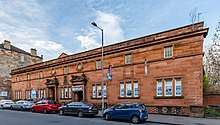Govanhill Baths
Govanhill Baths is a Category B listed Edwardian public bathhouse at 99 Calder Street, Govanhill, Glasgow, Scotland, designed by the architect A.B. McDonald and opened between 1912 and 1917.[1]

Design
Govanhill Baths is Glasgow's last surviving Edwardian public bathhouse.[2] The building contained hot baths in the upper storey and three swimming pools on the ground floor. There was a seating gallery around one of the pools for spectators attending events such as galas. The wash house, or "steamie", at the rear of the building, was converted to a launderette in 1971.[1][3]
History
The foundation stone for the new baths and wash-house was laid on 3 July 1914 by the Lord Provost of Glasgow, Sir Daniel Macaulay Stevenson.[4][5] An important function of the building in the early years was to provide clothes-washing facilities for local people whose tenement homes typically had no such facilities. Most homes in the area also lacked bathing facilities.[2] Local rumour has it that the baths were used as a temporary mortuary for casualties from bombing during World War II.[2][4]
Closure
The closure of the baths was announced in the Glasgow Evening Times on 6 January 2001. Glasgow City Council argued that the baths had too little use and were too expensive to refurbish and keep open.[4] The campaign to save the baths began almost straight away, and resulted in a community protest occupation of the building from 17 March until 7 August that year. Sheriff's officers accompanied by mounted police finally removed the protesters and shuttered the windows and doors with steel.[6] A picket line remained outside the baths for the following year, supported by local community donations.[7]
Govanhill Baths Community Trust
The Govanhill Baths Community Trust campaigns to reopen the baths as a "Wellbeing Centre", supported by community trust initiative, the Center for Community Practice with enterprise, research and development as well as a charity shop, and subscribing members. The trust manages community well-being projects and produces a newsletter.[8]
Today
Since its closure in 2001, Govanhill Baths has been the site of a variety of events meant to campaign for and promote awareness, including theatre and musical performances, art installations, and a skate-park. These events sped up action to reopen the pools, which began experiencing severe decay to the interior.[2]
In 2012, the smallest of the three pools, the "teaching" pool, was reopened and locals were interviewed expressing relief and recounting long memories of the bath house. This step was financed by the National Theatre of Scotland for use in their production, Lifeguard. A three-step plan was made to transform the building with Turkish and sauna suites, an allotment, a community café and music venue. Some had to be turned away from the front doors when they arrived with towels and swimming gear as the initial refilling was a test of the pools integrity to confirm its viability for returning to use.[7]
The baths are not just used for swimming. The building was a planned venue for the Big Huge Poetry Splash in 2012, part of National Poetry Day,[9] and the following year the Baths hosted its first marriage ceremony.[10] Artists who have exhibited at the baths include Anthea Hamilton and Nicholas Byrne, as part of the 2014 Glasgow International biennial visual arts festival.[11] In 2019, Ann Vance created a pastel portrait of Jessie Stephen and a monotype portrait of Margaret Skinnider for their Govanhill Women's Suffrage Project. [12]
There is a community archive, which aims to record the history of the baths through collecting and cataloguing items that reflect the heritage of the building and its activities. [13]
References
- Historic Environment Scotland. "99 Calder Street, Kingarth Lane, Calder Street Public Baths and Wash House (Category B) (LB33683)". Retrieved 28 March 2019.
- Levene, David (3 April 2014). "Disused Govanhill baths become art venue – in pictures". The Guardian. Retrieved 4 October 2014.
- Govanhill Public Baths and Wash-house (Glasgow City Archives, Department of Baths and Wash Houses, 1917), The Glasgow Story
- Timeline. Archived 1 January 2015 at the Wayback Machine Govanhill Baths Community Trust. Retrieved 18 November 2014.
- "Govanhill Baths... still afloat after 100 years". Evening Times.
- Origins. Govanhill Baths Community Trust. Retrieved 5 October 2014.
- McCloskey, Katy (24 May 2012). "Back in the baths: Govanhill celebrates as water fills pool". STV. Retrieved 4 October 2014.
- Intro. Govanhill Baths Community Trust. Retrieved 4 October 2014.
- Provan, Gillian (27 September 2014). "Writers bring poetry to life in the heart of the city's famous landmarks". STV. Retrieved 27 September 2012.
- The Story of Glasgow’s Govanhill Baths. Scotcampus, 25 June 2014. Retrieved 4 October 2014.
- "Exhibition Anthea Hamilton & Nicholas Byrne Love". Glasgow International. Retrieved 4 October 2014.
- McEachern, Gillian. "Suffra-jiu-jitsu: New Exhibition sheds light on little known facts about Scotland's suffragettes". Retrieved 13 March 2019.
- "Archive - Govanhill Baths". Govanhill Baths. Retrieved 14 March 2019.
External links
| Wikimedia Commons has media related to Govanhill Baths. |